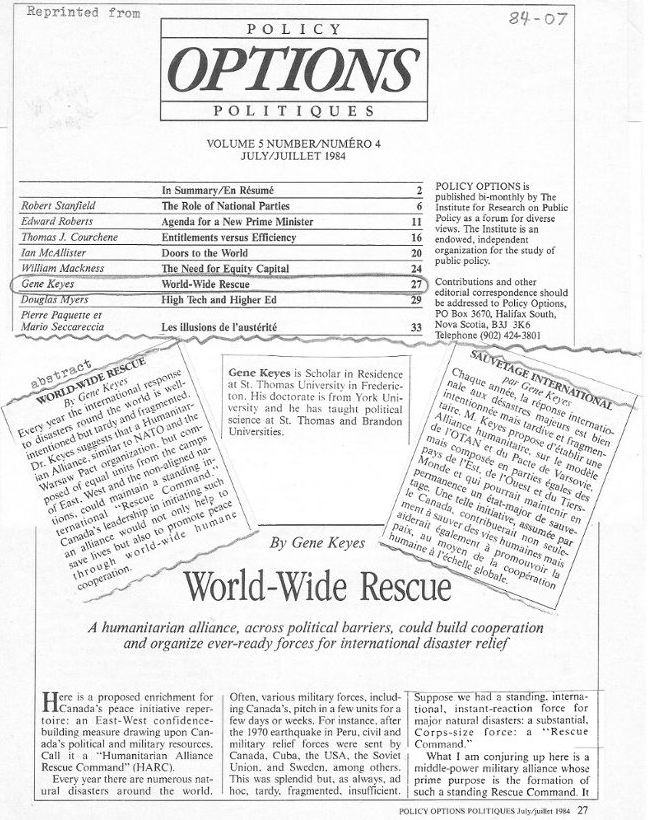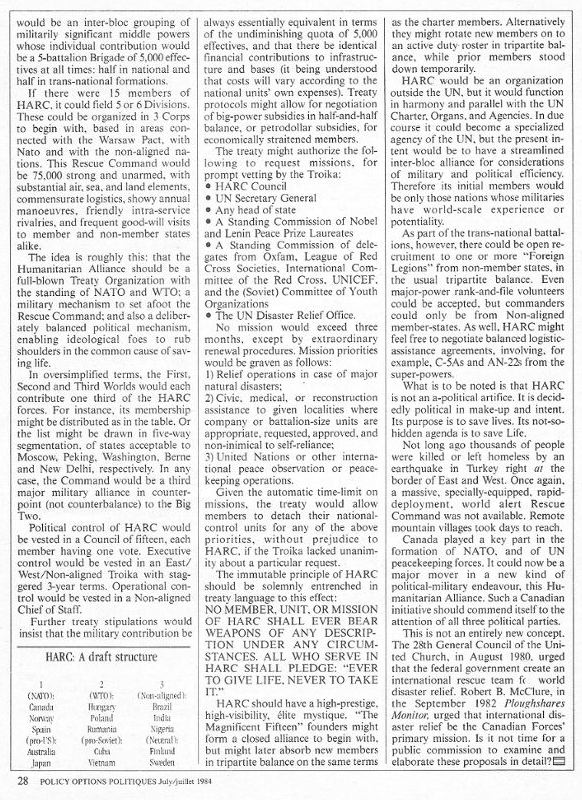
|
World-Wide Rescue
2014-10-04 Note: This is a reprint of a two-page article by me from 30 years ago, advocating that Canada take the lead in organizing a permanent international rescue command, 75,000 strong. Some details are out of date, but the general principle is still apropos, given the continual recurremce of global disasters both natural and artificial. The text is reproduced further below in HTML, for search purposes; and before that are jpegs of the article itself. --gk |

|

|
|
Reprinted from Policy Options, 1984-07, p. 27-28.
By Gene KeyesWorld-Wide Rescue
A humanitarian alliance, across political barriers, could build cooperation and organize ever-ready forces for international disaster relief. Abstracts
Here is a proposed enrichment
for Canada's peace initiative repertoire: an East-West confidence building
measure drawing upon Canada's political and military resources. Call it a
"Humanitarian Alliance Rescue Command" (HARC).
Each year there are numerous natural disasters around the world. Often, various military forces, including Canada's, pitch in a few units for a few days or weeks. For instance, after the 1970 earthquake in Peru, civil and military relief forces were sent by Canada, Cuba, the USA, the Soviet Union, and Sweden, among others. This was splendid but, as always, ad hoc, tardy, fragmented, insufficient. Suppose we had a standing international, instant reaction force for major natural disasters: a substantial, Corps-size force: a "Rescue Command". What I am conjuring up here is a middle-power military alliance whose prime purpose is the formation of such a standing Rescue Command. It would be an inter-bloc grouping of militarily significant middle powers whose individual contribution would be a 5-battalion Brigade of 5,000 effectives at all times, half in natonal and half in trans-national formations. |
|
If there were 15 members of HARC, it could field
5 or 6 Divisions. These could be organized in 3 Corps to begin with, based
in areas connected with the Warsaw Pact, with NATO, and with the non-aligned
nations. The Rescue Command would be 75,000 strong and unarmed, with substantial
air, sea, and land elements, commensurate logistics, showy annual manoeuvres,
friendly intra-service rivalries, and frequent good-will visits to member
and non-member states alike.
The idea is roughly this: that the Humanitarian Alliance should be a full-blown Treaty Organization with the standing of NATO and WTO; a military mechanism to set afoot the Rescue Command; and also a deliberately balanced political mechanism enabling ideological foes to rub shoulders in the common cause of saving life. In oversimplified terms, the First, Second and Third Worlds would each contribute one third of the HARC forces. For instance, its membership might be distributed the table below. Or the list might be drawn in five-way segmentation, of states acceptable to Moscow, Peking, Washington, Berne and New Delhi, respectively. In any case, the Command would be a third major military alliance in counterpoint (not counterbalance) to the Big Two.
Political control of HARC would be vested in a Council of fifteen, each member having one vote. Executive control would be vested in an East / West / Non-aligned Troika with staggered 3-year terms. Operational control would be vested in a Non-aligned Chief of Staff. Further treaty stipulations would insist that the military contribution be always essentially equivalent in terms of the undiminishing quota of 5,000 effectives, and that there be identical financial contributions to infrastructure and bases (it being understood that costs will vary according to the natonal units' own expenses). Treaty protocols might allow for negotiation of big-power subsidies in half-and-half balance, or petrodollar subsidies, for economically straitened members. The treaty might authorize the following to request missions, for prompt vetting by the Troika:
The immutable principle of HARC should be solemnly entrenched in treaty language to this effect: NO MEMBER, UNIT, OR MISSION OF HARC SHALL EVER BEAR WEAPONS OF ANY DESCRIPTION UNDER ANY CIRCUMSTANCES. ALL WHO SERVE IN HARC SHALL PLEDGE: "EVER TO GIVE LIFE; NEVER TO TAKE IT."HARC should have a high-prestige, high visibility, élite mystique. "The Magnificent Fifteen" founders might form a closed alliance to begin with, but might later absorb new members in tripartite balance on the same terms as the charter members. Alternatively they might rotate new members onto an active duty roster in tripartite balance, while prior members stood down temporarily. HARC would be an organization outside the UN, but it would function in harmony and parallel with the UN Charter Organs and Agencies. In due course it could become a specialized agency of the UN, but the present intent would be to have a streamlined inter-bloc alliance for considerations of military and political efficiency. Therefore its initial members would be only those nations whose militaries have world-scale experience or potentiality. As part of the trans-national battalions, however,
there could be open recruitment to one or more "Foreign Legions" from non-member
states, in the usual tripartite balance. Even major-power rank-and-file volunteers
could be accepted, but commanders could only be from Non-aligned member-states.
As well, HARC might feel free to negotiate balanced logistic assistance agreements,
involving, for example, C-5As and AN-23s from the super-powers.
What is to be noted is that HARC is not an a-political artifice. It is decidedly political in make-up and intent. Its purpose is to save lives. Its no-so-hidden agenda is to save Life. Not long ago thousands of people were killed or left homeless by an earthquake in Turkey right at the border of East and West. Once again, a massive, specially-equipped, rapid-deployment, world alert Rescue Command was not available. Remote mountain villages took days to reach. Canada played a key part in the formation of NATO, and of the UN peacekeeping forces. It could now be a major mover in a new kind of political-military endeavour, this Humanitarian Alliance. Such a Canadian initiative should commend itself to the attention of all three political parties. This is not an entirely new concept. The 28th General Council of the United Church, in August, 1980, urged that the federal government create an international rescue team for world disaster relief. Robert B. McClure, in the September 1982 Ploughshares Monitor, urged that international disaster relief be the Canadian Forces' primary mission. Is it not time for a public commission to examine and elaborate these proposals in detail?
|
|||||||||||||||||||||||||||||||
|
Related works by Gene Keyes:
"Mercy Force", article in USA Today, 1992-02-24, with title
"Big Human Needs Cry for Big Answers" (HTML version, plus jpeg of original newspaper print;) To Give Life: A Nonkilling Military Precedents and Possibilities 70-page illustrated monograph exploring these ideas in wider scope. (2014) |